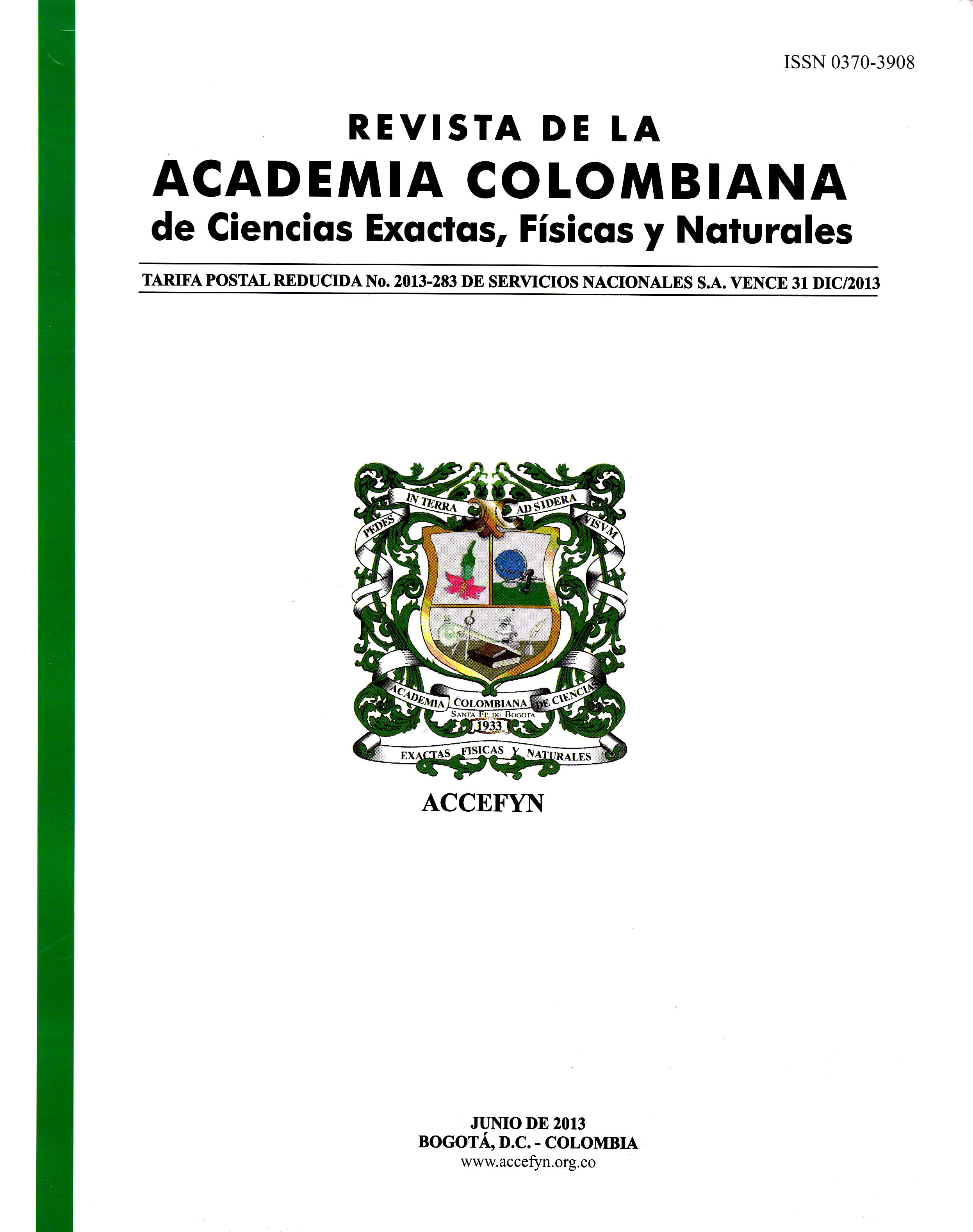Resumen
En este artículo se describe la preparación de hidrogeles a partir de acrilamida (AA) y ácido alilmalónico (AAM) en diferentes proporciones, por polimerización vía radicales libres en solución acuosa. El ácido alilmalónico se preparó por síntesis malónica a partir de malonato de dimetilo y bromuro de alilo. Los hidrogeles obtenidos se caracterizaron por espectroscopía infrarroja con transformada de Fourier (FTIR) y por calorimetría diferencial de barrido (DSC). Se estudió la cinética de hinchamiento de los hidrogeles en agua desionizada, a 27ºC, y 37ºC con diferentes valores de pH. Finalmente se estudió la cinética de liberación de ácido acetilsalicílico como ingrediente activo a 37ºC y pH = 7.4 (buffer de fosfatos).
Referencias
Allen, P.; Bennett, D. J.; Williams, D. 1992. Water in methacrylates I. Sorption and desorption properties of poly (2-hydroxyethyl methacrylate-coglycol dimethacrylate) networks. Eur. Polym. J. 28, 347-352.
Bajpai, S.; Johnson, S. 2006. Poly(acrylamide-co-maleic acid) Hydrogels for Removal of Cr (VI) from Aqueous olutions, Part 1: Synthesis and Swelling Characterization. J. Appl. Polym. Sci. 100, 2759-2769.
Bruck, S. 1973. Polymeric materials: Current status of biocompatibility. Biomater. Med. Devices, Artif. Org. 1, 79-98.
Caykara, T.; Dogmus, M. 2004. The effect of solvent composition on swelling and shrinking properties of poly (acrylamide-coitaconic acid) hydrogels. Eur. Polym. J. 40, 2605-2609.
El-Hamshary, H. 2007. Synthesis and water sorption studies of pH sensitive poly (acrylamide-co-itaconic acid) hydrogels. Eur. Polym. J. 43, 4830-4838.
Elliott, J; Macdonald, M; Nie, J; Bowman, C. 2004. Structure and swelling of poly (acrylic acid) hydrogels: effect of pH, ionic strength, and dilution on the crosslinked polymer structure. Polymer. 45, 1503-1510.
Fundueanu, G.; Constantin, M.; Stanciu, C.; Theodoridis, G.; Ascenzi, P. 2009. pH- and temperature-sensitive polymeric microspheres for drug delivery: the dissolution of copolymers modulates drug release. J Mater Sci: Mater Med. 20, 2465-2475.
Gallardo, A.; San Román, J. 1998. Contribución de los polímeros al diseño y desarrollo sistemas microencapsulados de interés biomédico Rev. Plastic. Modern. 75 (504), 577-581.
García, D; Escobar, J; Bada, N; Casquero, J; Hernáez, E; Katime, I. 2004. Synthesis and characterization of poly (methacrylic acid) hydrogels for metoclopramide delivery. Eur. Polym. J. 40, 1637-1643.
Karadag, E.; Saraydin, D.; Cetinkaya, S.; Giiven, O. 1996. In vitro swelling studies and preliminary biocompatibility evaluation of acrylamide-based hydrogels. Biomaterials. 17, 67-70.
Katime, I.; Novoa, R.; Díaz De Apodaca, E.; Mendizábal, E.; Puig, J. 1999. Theophylline release from poly (acrylic acid-coacrylamide) hydrogels. Polymer Testing. 18, 559-566.
Katime, I., Zuluaga, F. 2001. Swelling kinetics and release studies of theophylline and aminophylline from acrylic acid/n-alkyl methacrylate hydrogels. Eur. Polym. J. 37, 1465-1471.
Krusic, M.; Filipovic, J. 2006. Copolymer hydrogels base don N-isopropylacrylamide and itaconic acid. Polymer. 47, 148-155.
Krusic, M.; Ilic, M.; Filipovic, J. 2009. Swelling behaviour and paracetamol release from poly N-isopropylacrylamide-itaconic acid) hydrogels. Polym. Bull. 63, 197-211.
Parejo, C; Ortiz, C; Vázquez, B; Gallardo, A.; San Román, J. 1998. Hidrogeles polímeros para aplicaciones biomédicas. Comportamiento de sistemas neutros. Rev. Plastic. Modern. 75(499), 96-100.
Peppas, N. A.; Bures, P.; Leobandund, W.; Ichikawa, H. 2000. Hydrogels in pharmaceutical formulations. Eur. J. Pharm. Biopharm. 50, 27-46. ; Leobandung, W. 2004. Stimuli-sensitive hydrogels in chronotherapeutic Applications. J. Biomater. Sci. Polym. Ed. 15, 125-144.
Prior-Cabanillas, A.; Quijada-Garrido, I.; Frutos, G.; Barrales-Rienda, J.M. 2005. Influence of the swelling history on the swelling kinetics of stimuli-responsive poly [(N-isopropylacrylamide)-co-(methacrylic acid)] hydrogels. Polymer. 46,685-693.
Qiu, Y.; Park, K. 2001. Environment-sensitive hydrogels for drug delivery. Advanced Drug Delivery Reviews. 53, 321-339.
Ray, D.; Mohapatra D.; Mohapatra, R.; Mohanta, G.; Sahoo, P. 2008. Synthesis and colon-specific drug delivery of a poly (acrylic acid-coacrylamide)/MBA nanosized hydrogel. J. Biomater. Sci. Polymer Edn. 19, 1487-1502.
Ross-Murphy, S. B.; McEvoy, H. 1986. Fundamentals of hydrogels and gelation. Polym. J. 18, 2-7.
Sáez, V.; Hernáez, E.; Sanz, L. 2004. Mecanismos de liberación de fármacos desde materiales polímeros. Rev. Iberoam. Polim. 5 (1), 55-65.
Saraydin, D.; Ünver-Saraydin, S.; Karadag, E.; Koptagel, E.; Güven, O. 2004. In vivo biocompatibility of radiation crosslinked acrylamide copolymers. Nucl. Instr. and Meth. in Phys. Res B. 217, 281-292.
Shibayama, M.; Tanaka, T. 1993. Volume phase transition and related phenomena of polymer gels. Adv. Polym. Sci. 109, 1-62.
Üzüm, Ö.; Karadag, E. 2005. Equilibrium Swelling Studies of Highly Swollen Acrylamide/Mesaconic Acid Hydrogels. J. Appl. Polym. Sci. 96, 2253-2259.

Esta obra está bajo una licencia internacional Creative Commons Atribución-NoComercial-SinDerivadas 4.0.
Derechos de autor 2023 Revista de la Academia Colombiana de Ciencias Exactas, Físicas y Naturales

